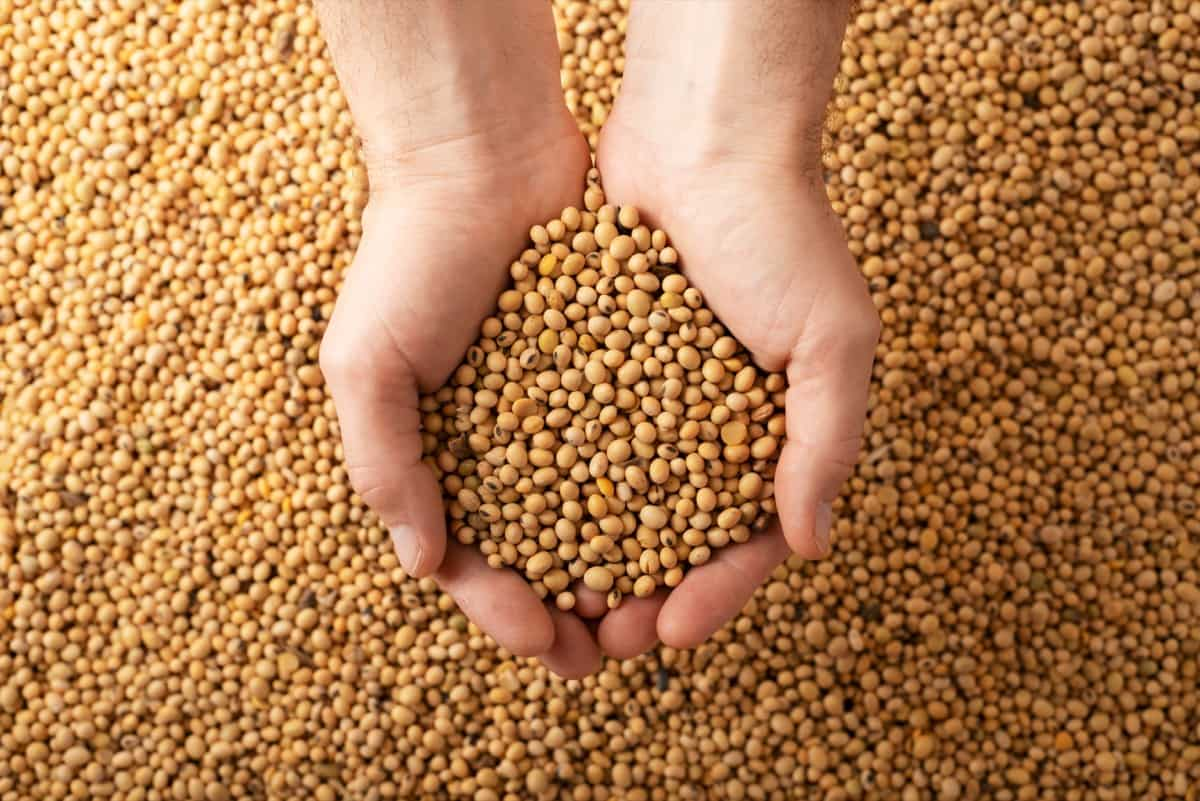Soybean farming is a popular and profitable business venture. Soybean farming is a profitable agricultural business providing income over several years. Soybeans are versatile crops used for various purposes, including human consumption, animal feed, and biodiesel production. Soybeans are high in protein and contain all the essential amino acids for human nutrition.

Soybean Farming Business Plan
Benefits of Soybean Farming
- The demand for Soybeans is high and growing. Another reason to start a Soybean business is that it can be a profitable venture.
- Soybeans are relatively easy to grow and yield a good return on investment. In addition, the cost of starting a Soybean farm is relatively low compared to other types of businesses.
- Starting a Soybean business provides an opportunity to impact the environment positively.
- Soybeans are a renewable resource whose production has a minimal negative environmental impact. As consumer awareness of environmental issues grows, so does the demand for environmentally friendly products.
- By starting a Soybean business, you can be at the forefront of this growing trend and make a difference in the world.
- Soybeans are a relatively easy crop to grow; thus, farmers can count on a certain level of income stability.
- Soybeans are known for their health benefits for humans and animals. This means that farmers can feel good about growing a crop that benefits people and animals alike.
- Soybeans are also a very sustainable crop, requiring little input (fertilizers, pesticides, etc.) and having a small environmental footprint. This is good news for both the farmer and the planet.
Soil Management and Seed Rate for Soybean Farming
The ideal pH range for Soybean plants is between 6 and 7.5. Within this range, the plant can access the nutrients it needs from the soil and is less likely to experience stress from extreme pH conditions. Farmers can test their soil regularly and adjust its pH with limestone or other amendments to maintain a favorable pH for Soybeans.
Seed Rate and Proper Spacing for Successful Soybean Business
- The optimum seed rate for sowing on one-acre land is 25-30 kg. This will ensure that the chances of getting a good crop are high. More seeds should not be sown as this will lead to competition amongst the plants for resources and, ultimately, lower yields.
- Soybean farming is a popular and profitable agricultural business in many parts of the world. The crop is mostly cultivated in countries with tropical and subtropical climates. India is the leading producer of Soybeans, followed by Brazil, Argentina, and the United States.
- The plant grows well in fertile soils with good drainage. A spacing of 45-60 cm X 2.5 cm is considered suitable for Kharif crops, while 30-45 X 2.5 cm is ideal for spring season cultivation.
- Proper spacing is essential for optimum yield as it allows proper aeration and sunlight penetration to the lower leaves. It also helps in controlling weeds and pests.
In case you missed it: Best Regenerative Agriculture Practices Every Grower Should Follow and Why It Is Important

Fertilizers and Water Requirement to Start Soybean Farming Business
Fertilizers play an important role in Soybean production as they help to supply the nutrients required for plant growth. The type and amount of fertilizer used will vary depending on the soil type, crop rotation, and previous crop history. It is important to have your soil tested before applying fertilizer to ensure you use the correct products and rates.
Water is also a critical factor in Soybean production. The water needed will vary depending on the climate and weather conditions. Irrigation systems should be designed and operated to minimize evaporation and runoff.
Tips to Create Soybean Farming Business
- The first step in starting a Soybean farm is to create a business plan. This plan should include an analysis of the market, your competition, your start-up costs, and your operating expenses. Once you have created a business plan, you can look for land to grow your Soybeans.
- Once you have secured land for your farm, you must obtain permits and licenses from your local government. You must also purchase seeds from a reputable supplier and the necessary fertilizers and pesticides.
- After planting your seeds, you must water them regularly and closely monitor their growth. Once your Soybeans are ready for harvest, you can sell them directly to customers or through a wholesaler.
- The demand for Soybeans is constantly growing, creating opportunities for farmers to profit. Producing a high-quality product that meets customer demands is important to maximize profits. Additionally, farmers must have a good marketing strategy to ensure their products are sold fairly.
Selecting the Seed for Soybean Framing Business
The type of climate in which you will be growing your Soybeans, the soil type, and the amount of rainfall are just a few of the things that will affect what type of seed you choose. You will need to decide whether you want to grow your Soybeans organically. If you choose to grow them organically, there are a few additional steps that you will need to take to ensure that your plants are healthy and free of pesticides and herbicides.
In case you missed it: Best Fertilizer for Soybean Crop: Organic, Compost, NPK, When and How To Apply

When selecting the seed for your Soybean farming business plan, it is important to consult with a local expert who can help you determine which type of seed will best suit your needs. Once you have selected the right type of seed for your farm, you must purchase it from a reputable source. Ask about return policies if the seed does not germinate or the plants do not thrive.
Licenses & Permits to Start Your Soybean Farming Business
- The first step is to obtain a business license from your local government.
- Next, you must get a Soybean farming permit from the Department of Agriculture.
- Finally, you must obtain a Food and Drug Administration (FDA) license.
Soybean Business Cultivation Practices
- Cultivating a Soybean crop is no different than any other bean crop. The main difference is the variety of Soybean that you choose to grow. There are many varieties of Soybeans, each with its benefits and drawbacks. You must select the best variety for your particular climate and soil type.
- Once you have selected the right Soybean variety, you must prepare your soil. Soybeans require well-drained, fertile soil to thrive. The best method to achieve this is by conducting a soil test and following the recommendations for amendments.
- After your soil is prepared, you will need to plant your seeds. Soybeans are typically planted in late spring or early summer. Throughout the growing season, Soybeans will need to be watered regularly. They are especially susceptible to drought stress during flowering and pod filling. Keep an eye on your crop’s weather forecast and irrigation needs.
- As harvest time approaches, scout your field for diseases and pests. These can cause serious damage to your crop if left unchecked. Treat any problems immediately according to the label directions. When the beans are mature, they can be harvested by hand or with a combine harvester.
Steps to Maximize the Soybean Crop Yield
- Selecting the suitable variety: Many Soybeans are available. Select the one that is best suited for your field conditions.
- Sowing at the right time: Timing is crucial for getting a good yield. Sow the seeds when the conditions are favorable for germination and growth.
- Proper spacing: Maintaining proper distance between plants ensures good air circulation and exposure to sunlight. This will prevent diseases and encourage growth.
- Adequate fertilizer: Use quality fertilizer to provide nutrients for optimal growth. Apply it at recommended rates and at the right time.
- Proper irrigation: Irrigate the crop regularly to keep the soil moisture consistent. Avoid waterlogging as it can lead to root rot.
- Pest and disease control: Regularly check for pests and diseases and take corrective measures immediately. This will help prevent crop damage and maintain a good yield.
In case you missed it: Top 19 Steps to Boost Soybean Yield: How to Increase Production, Quality, Size, and Tips

Crop Rotation and Inter Cropping to Start Soybean Farming
Crop rotation and inter-cropping are both important aspects of Soybean farming. Crop rotation helps replenish the soil’s nutrients, while inter-cropping allows different crops to be grown in the same field. Inter-cropping with Tur, Cotton, Sorghum, Cotton, and Sugarcane. It is rotated with Wheat, Potato, Gram, and Tobacco. This type of rotation provides a variety of nutrients for the plants and helps to prevent pests and diseases.
Soybean Farming Care
- Once you have your business plan, it’s time to find the perfect location for your farm. The ideal location will have good soil conditions and be close to markets where you can sell your Soybeans. Once you’ve found the perfect spot, it’s time to start preparing the land for planting.
- This involves clearing any debris, tilling the soil, and applying fertilizer. Once the land is ready, you can plant your Soybeans and grow your crop. Throughout the growing season, monitoring your plants and ensuring they get enough water and nutrients is important.
- Once harvest time arrives, you must carefully remove the Soybeans from their pods and then dry them before storing or selling them. With proper care and attention, your Soybean farming business can succeed.
Steps to Create a Soybean Farming Business Plan
- Research the market for Soybeans in your area. Determine if there is a demand for Soybeans and if businesses are already selling them in your area. Consider the price of Soybeans as well as the costs of production when making your decision.
- Before starting any business, it is important to research the market. This will help you understand the demand for Soybeans and the prices that farmers are getting for their crops.
- Create a business plan that should include information on your target market, marketing strategy, financial projections, and plans for production and distribution.
- Once you have found the perfect location for your farm, you must prepare the land for planting. This includes clearing debris, tilling the soil, and leveling off areas that might be too hilly or sloped.
In case you missed it: Pest and Disease Management in Soya: Causes, Symptoms, Chemical, and Biological Control

- Find a source of funding for your business. This could come from personal savings, loans, or investors.
- Purchase the necessary supplies and equipment for growing and processing Soybeans. This could include land, seed, fertilizer, irrigation equipment, etc.
- Plant the Soybeans and care for them throughout the growing season. This includes watering, weeding, and protecting them from pests and diseases.
- Pests and diseases can also decimate crops, making it difficult to profit. Soybean farmers must constantly be on the lookout for pests and diseases that could potentially damage their crops.
- Harvest the Soybeans when ready and process them into their final form (soy milk, tofu, etc.).
- Market and sell your products to customers in your area. This could be through online sales, farmer’s markets, retail stores, etc
Success Tips for a Soybean Business
- Location: The farm should be located in an area with a demand for Soybeans. This could be a local market or a regional or national market.
- Land: The farm should have enough land to grow the desired Soybeans. The land should also have good soil quality and adequate drainage.
- Equipment: The farm will need equipment for planting, harvesting, and transporting Soybeans. The equipment should be well-maintained and in good working condition.
- Farm workers: The farm will need workers for planting, harvesting, and transporting Soybeans. These workers should be reliable and honest. They should also be able to work long hours during peak times.
- Financing: The farm will need financial resources to cover start-up costs and ongoing operating expenses. This could come from personal savings, loans, or investments from others.
Soybean Harvesting and Yield
The main ways to harvest Soybeans are hand picking or machine harvesting. Hand-picking is a more labor-intensive method but can be done with minimal equipment. Machine harvesting is more expensive and requires specialized equipment, but it is much faster and easier. If you are hand-picking your Soybeans, wait until the pods are brown and dry before picking them. You can either shell the beans by hand or thresh them using a simple threshing machine. The average seed yield for Soybeans is about 6.1 to 7 quintals per acre.
In case you missed it: How to Start Soybean Farming in Kenya: A Step-By-Step Production Guide for Beginners

Conclusion
Soybean farming can be a rewarding business venture. With the right knowledge, you can create a successful Soybean farming plan that will ensure your success in the long run. Soybeans are one of the most versatile and nutritious crops in the world. Soybeans are a good protein source, making them an important part of many diets.
- Types of Pesticides Used in Agriculture: A Beginner’s Guide
- Economical Aquaculture: A Guide to Low-Budget Fish Farming
- 15 Common Planting Errors That Can Doom Your Fruit Trees
- How to Make Houseplants Bushy: Effective Tips and Ideas
- Innovative Strategies for Boosting Coconut Pollination and Yield
- Pollination Strategies for Maximum Pumpkin Yield
- The Complete Guide to Chicken Fattening: Strategies for Maximum Growth
- Natural Solutions for Tulip Problems: 100% Effective Remedies for Leaf and Bulb-Related Issues
- Revolutionizing Citrus Preservation: Towards a Healthier, Greener Future
- Natural Solutions for Peony Leaf and Flower Problems: 100% Effective Remedies
- Maximizing Profits with Avocado Contract Farming in India: A Comprehensive Guide
- Natural Solutions for Hydrangea Problems: 100% Effective Remedies for Leaf and Flowers
- The Ultimate Guide to Choosing the Perfect Foliage Friend: Bringing Life Indoors
- From Sunlight to Sustainability: 15 Ways to Use Solar Technology in Agriculture
- The Ultimate Guide to Dong Tao Chicken: Exploring from History to Raising
- The Eco-Friendly Makeover: How to Convert Your Unused Swimming Pool into a Fish Pond
- Mastering the Art of Delaware Chicken Farming: Essentials for Healthy Backyard Flocks
- 20 Best Homemade Fertilizers for Money Plant: DIY Recipes and Application Methods
- How to Craft a Comprehensive Free-Range Chicken Farming Business Plan
- Brighten Your Flock: Raising Easter Egger Chickens for Beauty and Bounty
- How to Optimize Your Poultry Egg Farm Business Plan with These Strategies
- Subsidy for Spirulina Cultivation: How Indian Government Schemes Encouraging Spirulina Farmers
- Ultimate Guide to Raising Dominique Chickens: Breeding, Feeding, Egg-Production, and Care
- Mastering the Art of Raising Jersey Giant Chickens: Care, Feeding, and More
- Ultimate Guide to Raising Legbar Chickens: Breeding, Farming Practices, Diet, Egg-Production
- How to Raise Welsummer Chickens: A Comprehensive Guide for Beginners
- How to Protect Indoor Plants in Winter: A Comprehensive Guide
- Ultimate Guide to Grow Bag Gardening: Tips, Tricks, and Planting Ideas for Urban Gardeners
- Guide to Lotus Cultivation: How to Propagate, Plant, Grow, Care, Cost, and Profit
- Agriculture Drone Subsidy Scheme: Government Kisan Subsidy, License, and How to Apply Online
- Ultimate Guide to Raising Araucana Chickens: Breed Profile, Farming Economics, Diet, and Care
- Bringing Hydroponics to Classroom: Importance, Benefits of Learning for School Students
- Ultimate Guide to Raising Polish Chickens: Breed Profile, Farming Economics, Diet, and Care
- Ultimate Guide to Raising Australorp Chickens: Profile, Farming Economics, Egg Production, Diet, and Care
- Silkie Chicken Farming: Raising Practices, Varieties, Egg Production, Diet, and Care
- Sussex Chicken Farming: Raising Practices, Varieties, Egg Production, Diet and Care
I enjoyed every bit of my reading on soybean farming. Please assist me in writing a soybean farming business plan proposal. It’s was very informative and recommend for those interested in farming to read through. Thanks